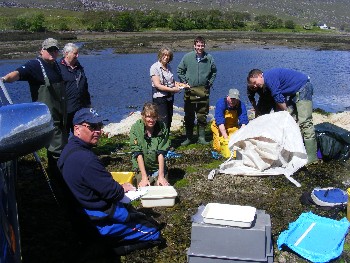On the occurrence of larger sea trout in Wester Ross
Posted: Monday 4 March, 2013 @ 16:29:13

The WRFT Sea trout Monitoring Report for 2012 can be found on the downloads page of this website or by clicking here.
This report presents the results of sea trout sampling in 2012 by WRFT. The report has been prepared primarily to inform local fisheries proprietors and managers, ghillies, anglers, salmon farmers and others who are interested in wild sea trout and sea lice management in Wester Ross.
The samples of sea trout reported here were caught using a sweep net in the River Kanaird estuary, Gruinard Bay, Loch Ewe, Loch Gairloch and the River Carron estuary; using a fyke net in the Dundonnell River estuary, and with rod and line in the sea pool of the River Ewe. In 2012, WRFT collected data from 383 trout. In addition to catching wee post-smolt sea trout (subject of the 2012 RAFTS post-smolt report) many larger sea trout were caught.
To learn about rates of survival (mortality) of sea trout in different parts of the area, subsamples of larger sea trout (fish of 310mm and larger) were treated separately. This size category was chosen in order to minimise sampling bias on the assumption that fish in this size class would be more evenly represented in sweep net catches relative to their actual abundance within respective sea trout populations than in samples including smaller fish; and also to allow comparison with samples taken in 1980 (Walker, 1980) and the 1920s (Nall, 1926 & 1938), and those from samples taken elsewhere in the West of Scotland.
For samples taken during the years 2007-2012, the subsample of these larger sea trout in Loch Gairloch was proportionality much larger relative to the total sample of sea trout taken than at the other sampling locations. However in Loch Gairloch, many sea trout were sampled during the winter, early spring and autumn: at times when other areas were not sampled. Many of the sea trout caught in Loch Gairloch were larger than the biggest sea trout taken in the MSS Shieldaig trap in Loch Torridon.
Of the respective subsamples of sea trout of 310mm in length and larger, 25% of the fish were of 410mm or more in length in the Kanaird, Dundonnell and Loch Gairloch subsamples. Only 11% of the Loch Ewe subsample and 8% of the River Carron subsample of sea trout of 310mm in length and larger were over 410mm in length. Sea trout of between 500mm and 600mm in length were caught in the Kanaird estuary, in Gruinard Bay and in Loch Gairloch but not at the other sampling locations (Dundonnell, Loch Ewe, Carron estuary). In contrast of a rod caught sample of sea trout of 310mm and larger taken in 1980, 58% were of 410mm or more and 4.3% were of 600mm or more (Walker, 1980).
These differences are considered in relation to sea trout survival/mortality rates, and are discussed in relation to levels of sea lice infection, salmon farm location, feeding opportunities, predation, and the movements of sea trout within respective freshwater – marine systems.
The findings in this report support the contention that rates of survival of sea trout in areas with salmon farms in the Wester Ross area during the period 2000 up to 2012 were inadequate to support traditional sea trout fisheries. Although there were many small post-smolts in some areas, very few of them survived to reach a size of 1kg (2.2lb). Records of larger trout, including rod caught fish, should be analysed further.
Thank you to everyone who helped with sea trout monitoring in 2012. Please contact WRFT Biologist (info@wrft.org.uk ) if you have any comments about this report or would like to help with sea trout monitoring in 2013.